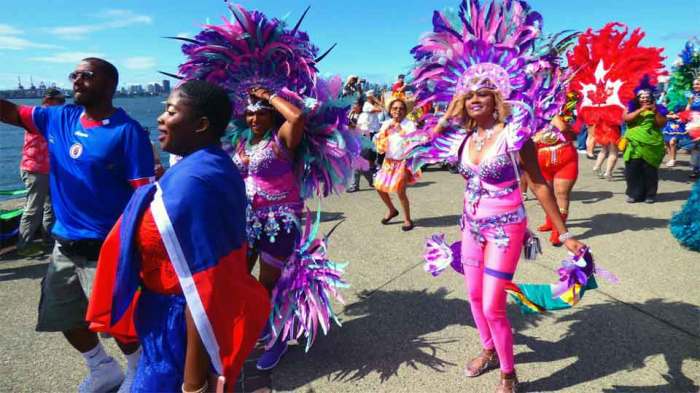Caribbean Festivals 2024 promise an explosion of color, music, and culture. From the pulsating rhythms of Trinidad Carnival to the vibrant Junkanoo parades of the Bahamas, these festivals offer a unique blend of history, tradition, and modern revelry. Get ready to immerse yourself in a world of dazzling costumes, tantalizing cuisine, and unforgettable experiences as we explore the heart and soul of Caribbean celebrations.
This year’s festivities boast a diverse lineup, each festival offering a distinct cultural flavor. We’ll delve into the historical roots of these events, examine their economic impact, and explore the efforts being made to ensure their sustainability. Prepare to be captivated by the sights, sounds, and tastes of the Caribbean, a region bursting with life and energy.
Festival Music and Dance: Caribbean Festivals 2024

Caribbean festivals are vibrant expressions of culture, history, and identity, and music and dance are undeniably at their heart. The rhythmic pulse of Caribbean music, interwoven with the expressive movements of its dances, creates an unforgettable experience for both participants and spectators. These traditions, passed down through generations, reflect the diverse influences that have shaped the region’s unique cultural tapestry.
Understanding the music and dance is key to truly appreciating the richness of Caribbean festivals.The dominant musical genres featured in Caribbean festivals are incredibly diverse, reflecting the island’s complex history. Each island boasts its own unique sounds, but certain genres transcend geographical boundaries.
Dominant Musical Genres in Caribbean Festivals
Caribbean festival music is a melting pot of influences, reflecting the region’s colonial past and its diverse populations. Soca, reggae, and calypso are just a few examples of the vibrant genres that dominate festival soundtracks. Soca, originating in Trinidad and Tobago, is characterized by its fast tempo, infectious rhythms, and often celebratory lyrics. Reggae, originating in Jamaica, is known for its laid-back rhythms, often incorporating social and political commentary.
Calypso, also from Trinidad and Tobago, features witty and often satirical lyrics delivered in a melodic style. These genres, along with others like zouk (Guadeloupe and Martinique) and kompa (Haiti), create a vibrant and diverse soundscape across the various festivals.
Junkanoo Dances and Their Cultural Significance
Junkanoo, a Bahamian festival celebrated annually, features elaborate costumes and highly energetic dances. The dances themselves are a powerful display of cultural pride and historical memory. The rhythmic movements, often accompanied by goatskin drums, cowbells, and whistles, tell stories of Bahamian history and tradition. Many of the dance moves are imitative, representing historical events or aspects of Bahamian life, demonstrating a connection between the past and the present.
The energy and precision of the dancers reflect the community’s spirit and dedication to preserving their heritage. Specific dance styles, such as the “running” and “circling” formations, create visually stunning displays that tell stories without words. The costumes, equally significant, enhance the narrative through their visual representation of historical figures and themes.
Comparative Analysis of Costumes in Two Caribbean Festivals, Caribbean Festivals 2024
The costumes worn in Caribbean festivals are not merely decorative; they are powerful symbols of cultural identity, history, and creativity. Comparing the costumes of Carnival in Trinidad and Tobago and Junkanoo in the Bahamas reveals fascinating differences and similarities. Trinidad Carnival costumes are often flamboyant and extravagant, showcasing intricate designs and bright colors. They frequently depict mythological creatures, historical figures, or abstract themes, reflecting the island’s rich cultural heritage and the creative spirit of its people.
The elaborate headdresses, feathered wings, and shimmering fabrics create a visually stunning spectacle. In contrast, Junkanoo costumes are often more structured and represent historical figures or themes, reflecting a focus on Bahamian history and traditions. While both utilize bright colors and intricate designs, the overall aesthetic and symbolic representation differ, highlighting the unique cultural identities of each festival.
The Trinidad Carnival costumes are more focused on fantasy and spectacle, whereas the Junkanoo costumes maintain a stronger connection to the history and cultural narratives of the Bahamas.
The Caribbean Festivals of 2024 are more than just events; they are a testament to the resilience, creativity, and vibrant spirit of the islands. From the infectious rhythms to the breathtaking visuals, these festivals offer a transformative experience, leaving a lasting impression on all who participate. So, plan your trip, embrace the culture, and create memories that will last a lifetime.
The economic benefits are significant, the cultural exchange is invaluable, and the sheer joy is undeniable. Don’t miss out!